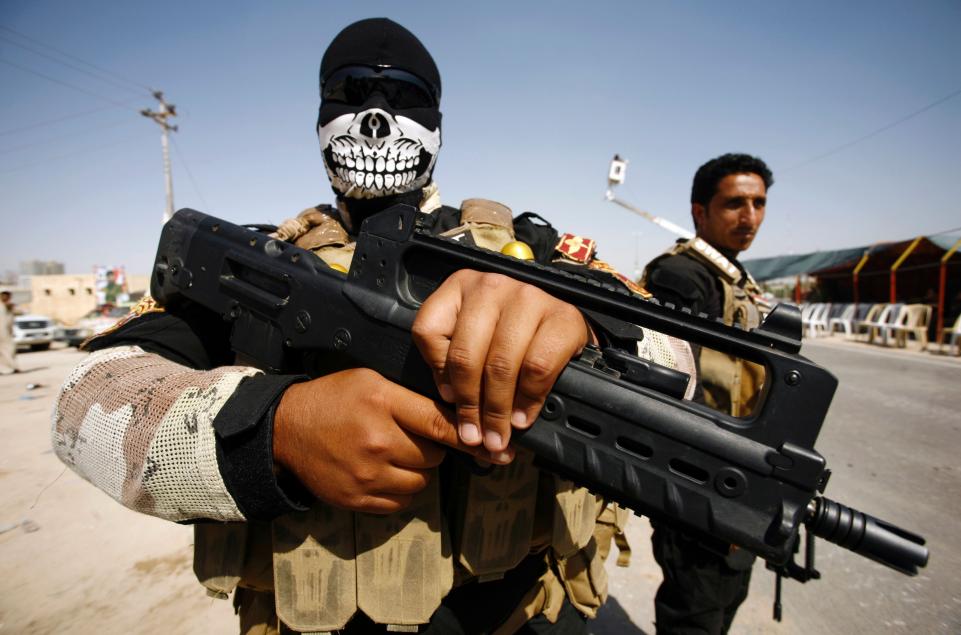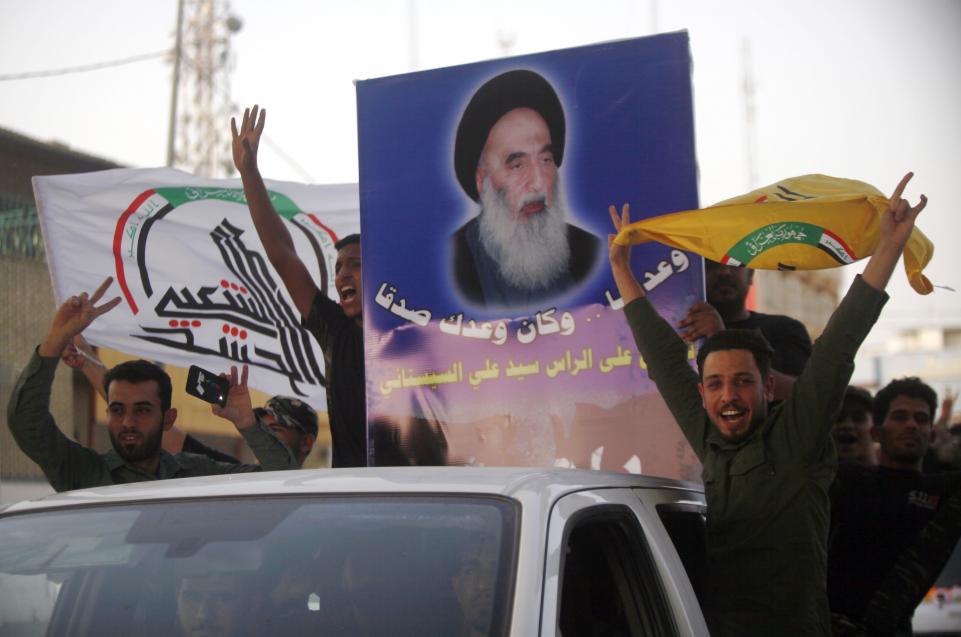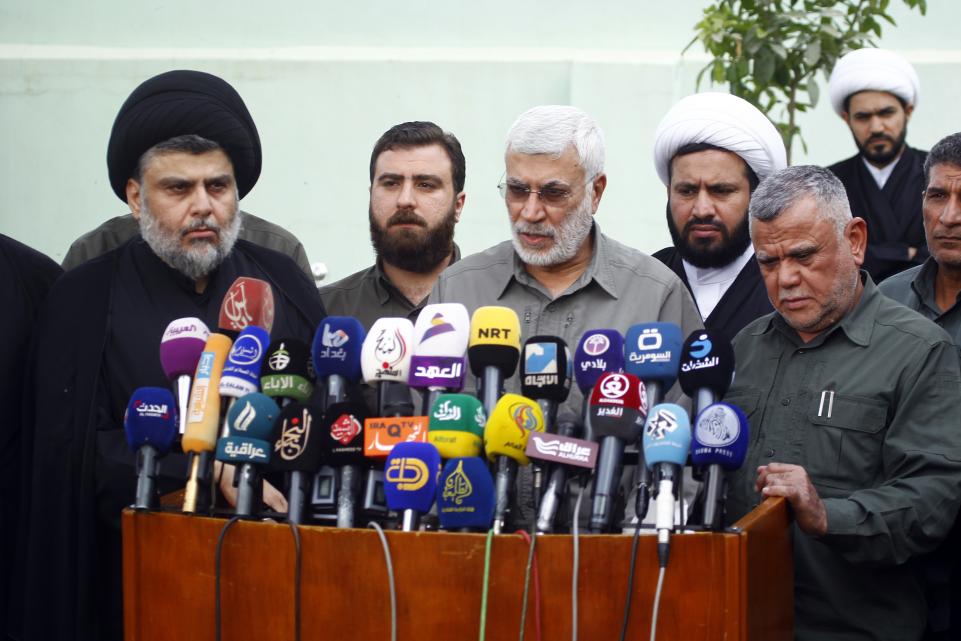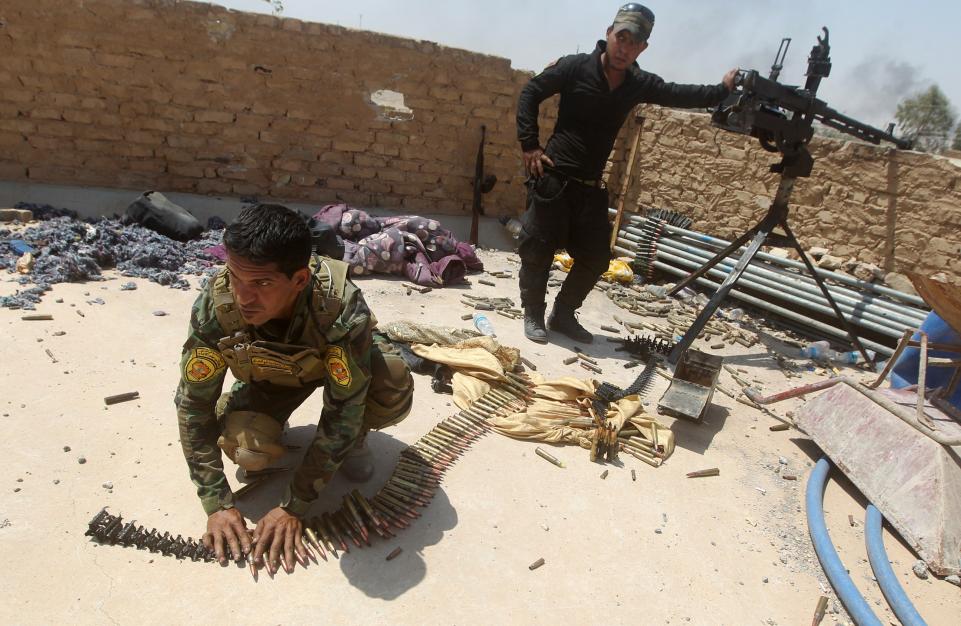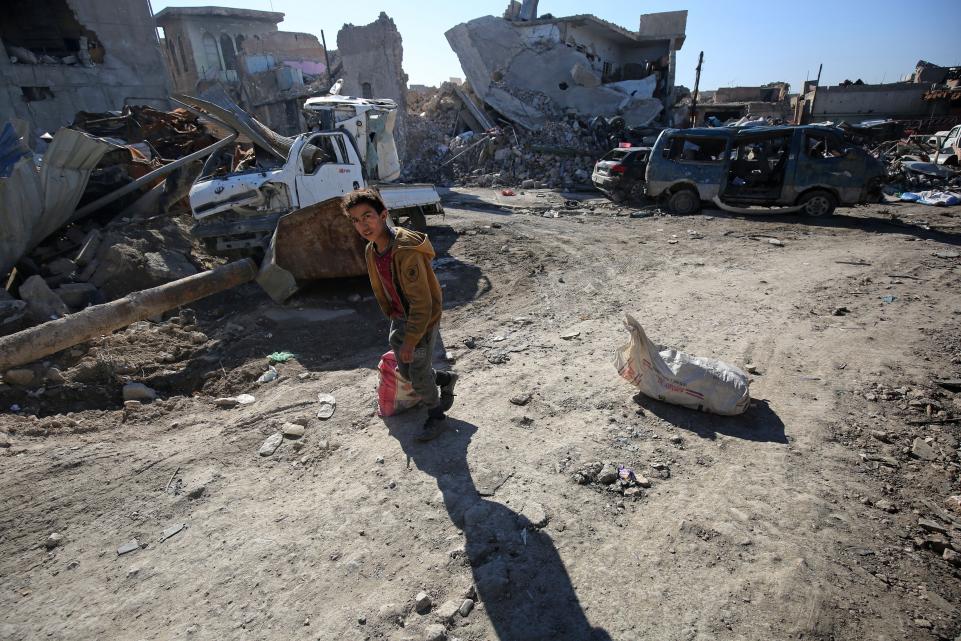When he describes the three years he spent fighting the Islamic State (ISIS) militant group everywhere from the banks of the Tigris to the Makhoul mountains and Iraq’s desert frontier with Syria, Mohammed Jassem doesn’t call himself a soldier.
Fresh from battle, flushed with victory, Mohammed Jassem is a Shiite holy warrior, a mujahid.
On his battered mobile phone, Jassem is playing a grainy video of the fighting in November 2017 in the deserts around al-Qa’im, the last ISIS-held town in Iraq before the vital strategic link in the militants’ once expansive supply network was liberated.
Orange tracer bullets illuminate the inky blue of the night’s sky as Jassem and his fellow mujahideen play their part in what they view as a centuries’ old battle of good versus evil, Sunni versus Shiite. Hunkered down behind a bank of sand, barely a dune, hundreds of high caliber rounds rip through the air just inches above their heads. The phone’s tiny speakers fail to do justice to the automatic gunfire, heavy and relentless.
“Look,” Jassem implores, wide-eyed. He turns and smiles before returning his eyes to screen.
A gray-haired former factory worker from Iraq’s deeply devout Shiite south, Jassem is one of the tens of thousands of Iraqis that rallied to the Hahid Shabi or Popular Mobilization Forces in the summer of 2014.
As ISIS overran vast swathes of the country and looked poised to take the capital, Baghdad, the leader of Iraq’s highest Shiite religious authority, Ayatollah Sistani, issued a fatwa, or religious edict, compelling all the faithful to protect their homeland from ISIS.
The militias were joined by Sunnis, Yazidis, Christians and other minorities, but in far lower numbers. As ISIS were pushed back from Tikrit and then Sunni strongholds in Fallujah, Ramadi and finally Mosul, it was the Shiite fighters—prominently backed by Iran—that led the way. Many Shiites now view the victory not only as a force of will, but an act of God.
Jassem’s brigade—Liwa Ali al-Akhbar—is affiliated to the Shrine of Imam Hussein in the southern city Karbala and views Sistani as its spiritual guide. By law, all of the militias that make up the Hashid Shaabi are under the authority of the Iraqi Prime Minister Haider al-Abadi, but the reality is far more complex. When they formed in 2014, the brigades coalesced around varied power structures: religious institutions, political parties, ethnic groups or old or defunct fighting groups. While they were fighting ISIS, the militias had a common goal. Now that ISIS is defeated, militia fighters have varying visions for the future of Iraq.
For Jassem, a former Iraqi special forces fighter under Saddam Hussein and later a factory worker, the competing aspirations of the various militias do not represent a problem. He sees no contradiction between following both Abadi and Sistani: “We have no orders. This is the prime minister’s discretion and he knows what we should do in the future. In addition to Ayatollah Sistani’s vision.”
For Jassem’s commander, Ali Hamdani, meanwhile, the fight against ISIS remains integral to any discussion of a new Iraq. Speaking to Newsweek at the end of 2017, Hamdani was buoyed by a string of victories—including, in July 2017, the fall of Mosul—but he still felt that the fight against the Sunni insurgent group was ongoing. In his deep baritone, Hamdani warned that stamping out the embers from the fire ISIS lit in the Iraq will at least take two more years.
This is why it is integral, he said, to keep the Hashid Shaabi fighters in liberated Sunni areas of Iraq—where they are at best viewed warily and at worst considered an occupying force. “In all areas of Iraq we have sacrificed. Those areas liberated by the Hashid Shaabi are where they should remain, to maintain security,” he says.
With that sacrifice has also come hard-won experience. After three years of war against a fearsome opponent, the Hashid are battle-hardened. For four months, Hamdani led his forces against elite ISIS fighters in the Makhoul mountains. “They were unable to capture even one foot of territory in those mountains.” In the full four-year campaign against ISIS, the Liwa Ali Akhbar lost 285 fighters— lionised by the community as martyrs—and 1,400 were wounded.
Hanging over the liberation of Mosul and other areas seized from ISIS has been the role of Iran, which openly backed the Hashid Shaabi militias (as well as Abadi) and whose top general, Qasem Soleimani, was pictured leading Shiite battalions in the early days of the conflict. President Donald Trump has been outspoken in his criticism of Tehran’s role in the Middle East, while both Saudi Arabia and Israel have eyed cautiously Iran’s growing military and political presence in Iraq.
Iraq’s Kurds have also criticized Iran. Before the battle to defeat ISIS was over, the coalition against the militants—the Hashid, government soldiers, the international community and the Kurdish Peshmerga—imploded, with Iraqi forces driving the Kurds from Kirkuk, a contested city seized by Kurdish forces early in the war. Iraqi Kurdistan’s regional government accused Iran, and Suleimani in particular, of orchestrating the attacks.
The Hashid deny that Soleimani was anywhere near the battlefield, although he was in Iraqi Kurdistan, apparently in the city of Sulaymaniyah, according to the Hashid Shaabi. After Kirkuk, Secretary of State Rex Tillerson said it was time for the Hashid Shaabi’s Iranian advisers to “go home.” Baghdad responded by warning the U.S. against meddling in its affairs, and by early 2018—with Abadi facing an election in May—the role of the Shiite militias and their Iranian backers in Iraqi politics was as prominent as ever.
One of Abadi’s key challengers in the upcoming elections is Hashid Shabi commander Hadi al-Amiri, who rose to prominence through the Badr Organization, an Iraqi paramilitary group backed by Iran. Abadi has countered by enlisting the support of Sistani and the powerful Shiite cleric Muqtada al-Sadr. Al-Sadr, who became the figurehead for the Shiite insurgency against the U.S. in the mid to late 2000s by raising the Mahdi Army. Along with Sistani, Al-Sadr has become Iraq’s king-maker.
But such political and international concerns do not trouble Hamdani, who rejects the narrative that the Hashid are either Iranian proxies or in the pocket of Iran. He evokes the Iran-Iraq War—fought between 1980 and 1988—as evidence of why Iranian and Iraqis could never fight alongside each other. “There are no Iranian fighters with us, and I say this truthfully. We fought against Iran over 20 years ago, for eight years,” he says, standing and retrieving a picture from the shelf in his small office of militia fighters gathered on the battlefield. “Do you see any Iranians in this picture?” he asks.
In the Sunni Triangle
The central Iraqi city of Tikrit was one of the first to be liberated from ISIS, in April 2015, and where once the streets echoed with the sounds of war—the explosion of a mortar round, the high frequency thud of automatic gunfire—now children run and play.
As the sun bathes Tikrit in a deep golden glow, just before it falls beyond the horizon, a wedding procession wends its way through the town. White cars wrapped in pink ribbon like birthday presents honk their horns as they pass the bombed-out husk of a half-finished mosque, or a dilapidated apartment building slumped to one side, its lower floors smashed into splinters of concrete.
For Iraq’s Sunnis, a Baghdad that is not only backed by Tehran but also in many ways indebted to the Shiite Iranians, any gratitude at liberation from ISIS has come alongside concern about a revival of the bitter sectarian conflict that tore through Iraq following the U.S. invasion in 2003.
At the height of the fightback against ISIS, before Iraqi forces had regained control of most of Iraq’s Sunni majority cities, the sectarianism that has plagued the country for decades played itself out once more.
In Anbar province in the cities of Fallujah, Ramadi and elsewhere atrocities were reported. Hundreds of Sunni men disappeared from Fallujah in the aftermath of the fighting after the city was liberated in June 2016. Shiite militiamen posed for grisly pictures with the desecrated bodies of ISIS fighters. In later operations to liberate ISIS’s Iraqi capital of Mosul, the U.S.-backed operation ensured the haashid were kept in the rear-guard liberating towns and installations away from the densely populated city.
Barely a mile into Tikrit, the president of the provincial council Ahmed Alkareem governs local affairs from behind two reinforced concrete walls. An accountant by training, and a member of a prominent local Sunni tribe he was elected to his post in 2013 just before the rise of ISIS, before the militants were able to convince the peoples of Iraq’s beleaguered Sunni Triangle they offered a better future than Baghdad. It is something Alkareem thinks could well happen again.
While life has returned to Tikrit, funding from the international community and a handful of NGOs has not completely repaired the damage done to the city’s general hospital. In the town of Bayji, 45 miles to the north, homes still lie in ruins and its inhabitants still live as refugees four years after the town was liberated.
Alkareem explains Salahdin province has been neglected by the government in Baghdad, relative to Anbar province which was liberated later. He accepts that Anbar, where ISIS had more time to do more damage and where the battle to expunge the militants was more costly was in need of assistance but addes that this does not mean Salahdin was not also in need to aid. “Those things are true of us as well,” the provincial president says.
Alkareem feels the window for the government to keep the minority Sunnis on side is slowly closing and he has little faith their concerns will be met before it is too late. “At first a lot of people were feeling sympathetic to ISIS because they thought it was a revolution against the government,” he says.
“However, unfortunately the federal government isn’t taking advantage of this change in the people’s way of thinking. They are not reaping the benefits,” he adds as he explains that as local Sunnis feel their rights continue to be trampled upon and if salaries and unemployment are not improved then history could repeat itself.
Alongside getting Saladin’s oil refinery, its fertilizer factory and other manufacturing plants in the area back up to speed, problems caused by local militias have become chief among Alkareem’s concerns. The roads in and out of Tikrit are lined with the benevolent faces of Ayatollah Sistani and Muqtada Al-Sadr, its checkpoints are manned by fighters from Al-Sadr’s Sarraya al-Salam brigade.
The problems of a long term paramilitary presence on the ground in Sunni Iraq has become a reality in Saladin province. Alkareem explains that the Hashid he deals with are now more interested in material gain and power than enforcing security. “The existence of such groups carrying weapons in our area is not a good thing. They are interfering with the residents as well as the government. A lot of the government dealings, they are interfering with. Their role is becoming more materialistic than it is security.”
Alkareem explains the majority of the what he terms “interference” predominantly involves Shiite militiamen and the Sunni residents. As far as he is concerned, in the Sunni heartlands that fuelled and supported the ISIS advance the hashid have to be removed unless history is to repeat itself.
“The federal government, for their part, needs to strengthen the security forces. We don’t want people from the south coming and guarding our places,” he says.” We can do that on our own.”
The provincial president was elected to his post in 2013. His government was forced to flee Tirkit as it was overrun by ISIS, taking up residence in neighboring Samarra, one of the northernmost points in Iraq to withstand the militants’ advance. For months the city was subject to relentless attacks. Nevertheless, at the end of the struggle, and as southern Iraq celebrates, Alkareem counsels caution to the unfettered optimism he hears from his countrymen. “I don’t see a very bright future,” he says.
http://www.newsweek.com/after-isis-two-iraqs-emerge-irans-shadow-797370?utm_source=email&utm_medium=morning_brief&utm_campaign=newsletter&utm_content=headline&spMailingID=2865292&spUserID=MjAwODQ2NjQzNDES1&spJobID=970068806&spReportId=OTcwMDY4ODA2S0



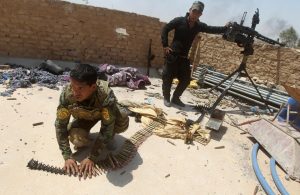 BY
BY 